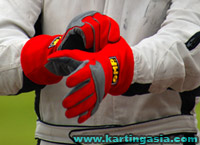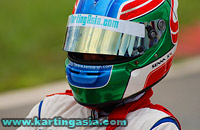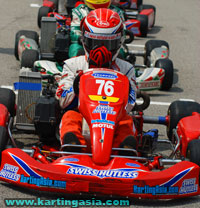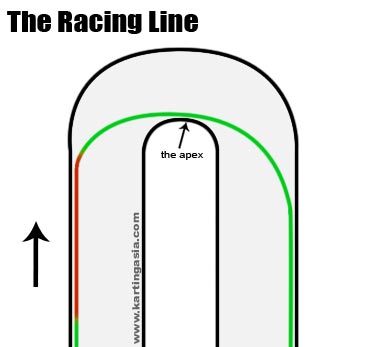This is the first in a series of articles intended for rental karters as well as those new to the sport to get the best experience and performance out of their karting. We’ll cover the very basics that are good for the first-time rental karter, but some of the info here could also help an experienced driver extract more performance. Everything in this article applies to both indoor and outdoor tracks unless otherwise mentioned.
Please note that this is a fairly long article. Do come back later to KartingAsia.com to read it if you don’t have the time now ;).
Get Comfortable!
Feeling comfortable in the kart is one of the most important aspects at any level of karting. Especially when you’re just getting started you want as few distractions as possible so that all your focus is on the driving. If you can’t reach the pedals, or you can’t see properly because your helmet is moving around you’re not giving your driving 100% and you’ll be losing time. Your clothing and seating position are critical.
Clothing
The first step in being comfortable in the kart is what you wear. Most karting establishments do a fairly good job in providing good helmets, suits, and gloves. At the kart tracks that don’t do such a great job it’s even more important that you’re well prepared.
We’ll start with your shoes. Don’t even think of showing up at a kart track with sandals or flip-flops. You’ll look like a twat and you won’t be able to control the pedals properly making you look even worse because you’ll be slow. What you’re looking for in shoes is protection (particularly ankle), and pedal feel.
The most common option is to wear sneakers (running shoes), preferably with a little bit of ankle-protection for safety. Everyone has a set of sneakers in their closet so bring those along. If you have a few pairs of sneakers take the ones that have the thinnest soles, because with the thinnest soles you’re able to feel the pedals the best. Don’t take your brand new runners because they’re bound to get a little scuffed-up. Much better than running shoes are actual karting/racing shoes. These have a very thin and soft rubber sole which allows optimum feel of the pedals.
Some boxing and wrestling shoes are also very good if you happen to have a pair of them somewhere. They are very similar to racing shoes with thin soles and good ankle protection.
There are a selection of racing-type shoes from Puma now readily available in sports stores typically labeled as casual footwear. While these are a good buy you’re still better off finding karting shoes from a kart shop because the rubber soles in the “mainstream racing” shoes are usually a little thicker or at least of a much harder rubber construction (because they’re designed as every-day shoes so they need to last).
 The good rental kart tracks provide gloves for you to use, however these are typically the cheapest gloves they could find. Some tracks don’t provide you with any gloves at all so if you’re looking to be karting fairly often you should get your own. Good gloves to provide protection and better feel of the steering allowing because with good gloves you don’t have to hold on to the wheel as hard as you would with your bear hands. Particularly when you get a little bit sweaty you start to lose grip on the plasticky rental kart steering wheels so you have to hold on tighter. When you hold the steering wheel tight you loose optimum feel and you get tired faster.
The good rental kart tracks provide gloves for you to use, however these are typically the cheapest gloves they could find. Some tracks don’t provide you with any gloves at all so if you’re looking to be karting fairly often you should get your own. Good gloves to provide protection and better feel of the steering allowing because with good gloves you don’t have to hold on to the wheel as hard as you would with your bear hands. Particularly when you get a little bit sweaty you start to lose grip on the plasticky rental kart steering wheels so you have to hold on tighter. When you hold the steering wheel tight you loose optimum feel and you get tired faster.
What you’re looking for in a glove is very little padding on your palm/fingers, so using weight-lifting gloves or bicycle gloves isn’t ideal because they typically have some padding on the palm side, however they are still much better than no gloves because they are usually designed to grip. If you ride a motorbike your gloves are probably great for karting so you can use those. They have thin material on the palm because you need good feel of the throttle/brakes/clutch and they’re designed to protect when you fall.
The best option is to buy gloves specifically designed for karting. Personal preference comes to play, however usually most drivers prefer gloves with stitching on the outside because it means you don’t get the seams under your fingers restricting your feel and resulting in blisters. Unfortunately the gloves with outside-seams are also the most expensive, so you have to spend a bit if that’s what you prefer. Sizing for gloves is important – too loose and they cause blisters because they fold-over in place – too tight and they won’t feel right and you’ll be restricting blood flow! Remember that gloves have to be the right size when you’re grabbing a steering wheel – so if possible when trying on gloves for size grab on to a steering wheel or a bar roughly the same diameter.
 If you don’t know if a kart track provides you with a karting suit to wear you should come prepared with jeans, and preferably a long-sleeve shirt as well. If you wear shorts and the track doesn’t provide you with a racing suit you’ll have the uncomfortable prospect of having air rush into your shorts and pushing them up possibly showing much more skin than you’re comfortable with! Additionally if you’re at an outdoor track you’ll have a lot of sand and other debris heading for you-know-where. Jeans stay in one place and they offer a bit of protection as well, just make sure they aren’t too tight so that they don’t restrict your movement.
If you don’t know if a kart track provides you with a karting suit to wear you should come prepared with jeans, and preferably a long-sleeve shirt as well. If you wear shorts and the track doesn’t provide you with a racing suit you’ll have the uncomfortable prospect of having air rush into your shorts and pushing them up possibly showing much more skin than you’re comfortable with! Additionally if you’re at an outdoor track you’ll have a lot of sand and other debris heading for you-know-where. Jeans stay in one place and they offer a bit of protection as well, just make sure they aren’t too tight so that they don’t restrict your movement.
For tracks that do provide you with a suit wear a good pair of boxers and a t-shirt. You’ll want to take your pants/shorts off when using a suit because it’ll bulk up and feel uncomfortable. Take time selecting the correct size, one that doesn’t restrict your movement while not having too much excess material floating around.
 One of the most dreaded things about rental karting is having to put on a helmet worn by hundreds of other drivers before you! The helmets don’t even get washed! The good rental places have quality helmets and have a drying system which keeps the helmets dry and they also supply cotton balaclavas that you throw in the laundry basket after you’re done.
One of the most dreaded things about rental karting is having to put on a helmet worn by hundreds of other drivers before you! The helmets don’t even get washed! The good rental places have quality helmets and have a drying system which keeps the helmets dry and they also supply cotton balaclavas that you throw in the laundry basket after you’re done.
If you don’t have your own helmet take time in selecting a good helmet from the rental track’s selection. Try on a helmet and if it fits, try on the next smaller size, and then the next smaller size until it starts getting impossible to put it on. Helmets should fit very snugly. If you can easily move the helmet side-to-side when it’s on your head you have to go smaller. It should be at least slightly difficult putting it on. Also before you try the helmet on have a look at the buckle-system and make sure you know how to use it.
When buying your helmet you should consider if you might be taking up karting competitively in a year or so? If yes you shouldn’t waste money on a “budget” helmet only to have to buy a proper one a year later. Look for a Snell rating on the helmet – either Snell SA2005(car) or K2005(kart). If you won’t be racing any time soon then for the top of the line you can add M2005 as well to the list. The main difference to M2005 is it’s meant for motorcycles. The visor is typically 2mm on a bike helmet whereas in the car or karting helmets it’s 3mm. The impact tests are very similar.
You can also safely buy a cheap helmet as long as it meets some kind of safety standard – look for DOT or BSI or ECE. The no.1 thing is to make sure it fits your head properly and is the correct size. If it’s loose not only will it not protect you properly in a crash but it will move around and disturb your driving.
Getting in the kart – Seating Position
 Now that we’ve got all that out of the way we’ll get to actually getting in the kart and making sure you’re comfortable in it. You’ll never get to the same level as you would in a race kart for which you’d buy a seat that fits you perfectly but you can do some things to get the best fit possible. The better your seating position the more you can concentrate on the driving and the more consistent you’ll be.
Now that we’ve got all that out of the way we’ll get to actually getting in the kart and making sure you’re comfortable in it. You’ll never get to the same level as you would in a race kart for which you’d buy a seat that fits you perfectly but you can do some things to get the best fit possible. The better your seating position the more you can concentrate on the driving and the more consistent you’ll be.
In rental karting you are usually forced to make a compromised decision on your seating position. The seats are designed to fit everyone – so for most they will be too big and you’ll be moving around a lot. Look around to see if the karts have different size seats and sit in a few to find the best one for you. Good rental kart operators have a few extra-large and a few extra-small seats to fit drivers in. Also check to see if they have seat-inserts if you’re struggling to find a good seat. Ideally you want a seat which will not let you move from side-to-side at all, but also one which doesn’t create any pressure-points which can cause pain.
In real sub-par rental kart places check the seat-bolts to make sure none of them will eat in to your back!
Many rental karts let you move the seat forward and backward a little, and some karts also have moveable pedals. Make full use of these adjustable features! The first thing to check is that you can reach the steering wheel properly. When sitting back in the seat you should be able to hold the wheel in the 9 and 3 position and still have your elbows bent. If they’re straight move the seat forward and if you can’t make sure you find a kart in which you can have your elbows bent.
The ideal position for your legs to be in is a little bit bent at the knees but not so much that you’re hitting the steering wheel. You have to be able to press the brake and throttle all the way without having to stretch or move around and you should still have a bit of a bend in the knees.
You’ll notice some problems with your seating position only once you’ve been on the track, so if you’re going for another go see what you could do to improve any problems you had
You should not be moving around in the kart a lot when driving. Sometimes it is necessary to lean over a bit particularly with your head/neck because you aren’t used to the forces and don’t have the karting-stamina yet. In general though it’s best to remain quite still and composed in the kart, extra movement makes you needlessly tired and takes attention away from the driving.
Driving
Now we’re at the part most will really be interested in… the actual driving and how to go fast! This will cover the very basics, and just like in anything else you have to master these basics first. Mastering the basics will get you to within a fraction of a second of the fast times, so before trying a lot of advanced techniques that you might have heard of make sure you have these under control.
The number one key to being fast in a rental kart is to keep the momentum up. The karts don’t accelerate fast and once they lose speed it takes a lot of time picking up the speed again. Which means you have to be smooth with all three inputs with which you control what the kart does: the throttle, the brake, and the steering. With braking you should try to get all or most of it done when your steering wheel is still pointing dead-straight. Karts only have rear brakes so it’s like using only your handbrake in a rear car.
The brake and the throttle should not be used at the same time. Some believe this to work on rental karts by keeping the revs up but somehow the fastest drivers don’t do it. The brakes are for slowing down, the throttle is for speeding up. You should aim to be on one or the other at almost all times – when you’re not on either one you are probably wasting time somewhere.
The Basic Racing Line
The aim at least for most drivers is to get around the track in the shortest possible amount of time. To do so we have to keep the fastest average speed possible throughout the track. Down the straights it is simple – just hammer the throttle and hold on. In the corners it gets more complicated.
Here’s a typical racing line through a hairpin at a rental track:

The simple rule to the racing line is to go out-in-out. You should be on the very outside edge of the track when you’re approaching a corner. You then turn into the corner and hit the apex on the inside of the corner. The apex is a term for the part where you “clip” the inside part of the track. You then go out again to the very edge of the track. If you aren’t using all of the track you’re losing time.Watch a formula one race and you’ll notice that in most corners the drivers are at the white line on the entry, they then hit the curb on the inside, and then go to the very outside edge of the track again often over a curb. Watching motorsports on tv in general is good for having a look at the racing line. Pay attention to how well drivers use all of the track.The line you take determines the speed that you can drive through the corner. If for example you drive on the very inside edge of the track your distance traveled will be shorter, but because you’re driving along a much tighter arc you have to drive a lot slower.
The key to going fast when you’re starting out is to go slow-in, and fast-out of corners. What this means is that you should focus your attention on getting a fast exit out of the corner so that you can carry that speed along the next straight and don’t spend time accelerating from a slow speed. Brake hard but don’t think that attacking the corner entry will be fast.
You should have the kart very stable when you’re entering the corner and you should be able to get back on the throttle almost immediately after you’ve started to turn the steering wheel. To ensure a fast exit you can sacrifice your entry speed a little by taking care to keep the kart well under control to allow for a rocket exit. If you know this and your friends don’t you’ll have them complaining that they catch you entering the corners yet you fly away down the straight! They’ll blame it on the kart but you’ll know the real reason.
Heading onto the track, relax!
When you’ve gotten in the kart and are heading for the track just remember the driving advice above and relax. Take the out-lap and the first few laps nice and easy to familiarize yourself with the kart and the track. Then start increasing speed little-by-little. Don’t think about attacking the track – think smooth, smooth, smooth and just let the times come to you.
Very often a new driver notices that their first lap was their fastest – because they weren’t pushing yet. Once they started attacking they started to lose time even though they thought they were going faster.Your entire body should remain relaxed – sit upright and drive by looking where you want to go and let your eyes do the steering rather than having a forced feeling to it.Be comfortable, smooth, relaxed, and remember these two: “out-in-out,” and “slow-in, fast-out.” Get those sorted and you’re already well on your way to beating your friends at the track. In the next article we’ll give some tips on picking the fast kart and much more advice on racing lines and driving techniques to improve your times.
Discuss this article in the Karting Techniques forum.